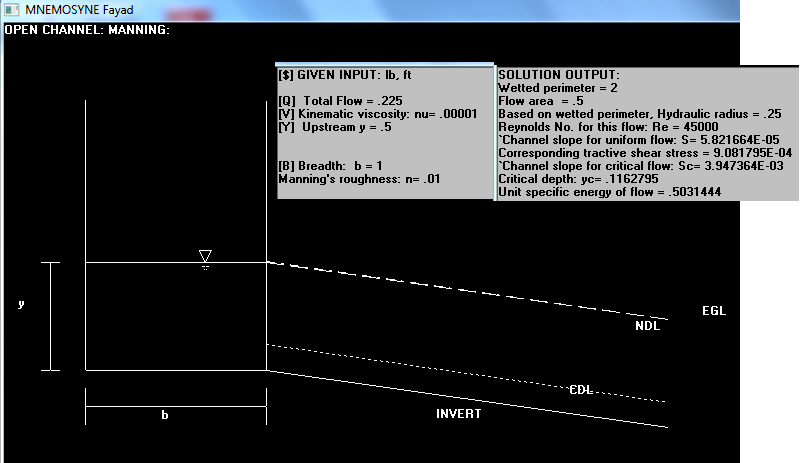Ali S. Fayad, Discoverer of The Explicit Alternate Flow Depth in Rectangular Open Channels
Normal Depth

[EGL: Energy Grade Line], [NDL: Normal Depth Line], [CDL: Critical Depth Line]
Normal Depth
CHANNEL: Manning's Uniform Flow
1- The final depth in a hydraulic jump is reported at 0.5 ft in a channel that is assumed horizontal. The flow is approximated at 0.225 fps. The Manning roughness constant for the newly and smoothly formed rectangular concrete channel is assumed at 0.01 (which will increase with time). The channel width is one foot. It is desired to verify the uniform flow and horizontalness assumption for the channel.
Analyze with MNEMOSYNE
SOLUTION:
Geometric & Physical Properties:
(a) Total flow =0.225 cfs, (b) upstream depth = 0.5, (c)breadth =1, (d)Manning's n= 0.01, (e)Kinematic viscosity =1e-5 (default for ft.ft/sec)
Results:
(a) Wetted perimeter = 2 ft, (b) flow area =0. 5 ft.ft, (c)slope for uniform flow = 5.82e-5 (d)hydraulic radius =0.25 ft, (e)Reynolds number = 45000.
Interpretation:
The drag of friction at the bottom, and sides, of a channel must be overcome by the tractive force of the water in a channel. This is a major part of the phenomenon of sediment deposition in natural channels. Uniform flow occurs when the water maintains the same depth relative to the bottom as it traverses the length of the channel. Manning empirically assigned roughness values for different types of channels. The value of the Manning roughness n is considered a constant for flow within an open channel under typical civil engineering applications for drainage and sewerage. The Chezy Manning Equation is used to relate the Chezy constant C to the hydraulic radius and the n value. Consequently, C is used to relate the velocity to the hydraulic radius and the slope of shallow channels that will provide uniform flow under the prevailing conditions. Care must be taken when applying the equation for slopes exceeding 1 in 10.
Verification:
In the above results, the Reynolds number is based on four times the hydraulic radius to allow comparison with the Moody chart for circular conduits. The value of the Reynolds number exceeds 4000 which means that the flow is turbulent (a necessary condition for the successful application of the Chezy-Manning equation). The slope is verified as being as horizontal as is practically attainable.
Sample Input/Output from Mnemosyne Fayad
------------------------------------------
OPEN CHANNEL: MANNING
[$] GIVEN INPUT: lb, ft
[Q] Total Flow = .225
[V] Kinematic viscosity: nu= .00001
[Y] Upstream y = .5
[B] Breadth: b = 1
Manning's roughness: n= .01
------------------------------------------
OPEN CHANNEL: MANNING
Wetted perimeter = 2
Flow area = .5
Based on wetted perimeter, Hydraulic radius = .25
Reynolds No. for this flow: Re = 45000
`Channel slope for uniform flow: S= 5.821664E-05
Corresponding tractive shear stress = 9.081795E-04
`Channel slope for critical flow: Sc= 3.947364E-03
Critical depth: yc= .1162795
------------------------------------------
Copyright 2012 Ali S. Fayad, Discoverer of The Explicit Alternate Flow Depth for Rectangular Open Channels. All rights reserved.
